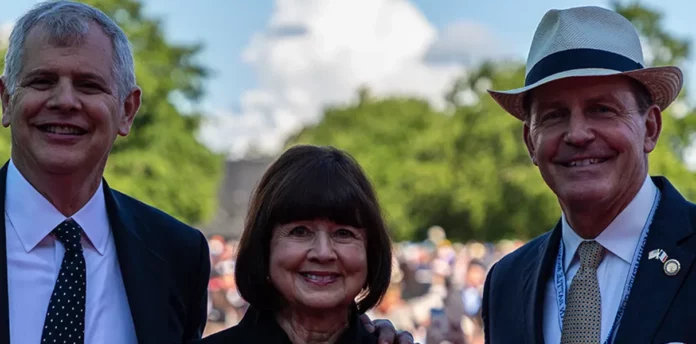Robert Dalessandro lives by Robert Dalessandro’s motto: “Time won’t dimen the glory of their acts.”
Former U.S. Army Officer, historian, author, and Gulf War veteran, is now the deputy secretary and leader for the American Battle Monuments Commission. His team in the world is responsible for the preservation of the memories of more than 200k American soldiers and civilians who were killed in combat overseas.
Arlington, Va., home to the ABMC, is preparing for Memorial Day ceremonies at 26 American military cemeteries all over the globe, from France and the Philippines.
The commission manages a global network consisting of 32 memorials to America’s fallen.
Livestreaming of the ABMC’s Memorial Day services will be available Monday at 9 a.m. from the Netherlands American Cemetery, Holland by the ABMC ET.
His Navy officer father, Lt.Cdr. Joseph Dalessandro was often assigned to the Pentagon, northern Virginia, or the huge naval port of Norfolk, at the mouth Chesapeake Bay.
Dalessandro served 29 years in the Army (1980-1909) as an operational and “history” officer. This included a stint at the U.S. Army Center for Military History. He was promoted to the rank colonel.
Family trips to Gettysburg in Pennsylvania inspired his love for history and desire to preserve the memories American war heroes.
He was a young boy who marvelled at the monuments to the dead that were scattered across the battlefield — some large in scale, others small and touching in their reverent simplicity.
He said that at ABMC “it is our duty, every day, to take care those who gave the final full measure,” Dalessandro said. The last four words were a poetic reference from Lincoln’s Gettysburg Address to the fallen.
Before he was awarded his Army commission, Dalessandro studied at the Virginia Military Institute. He has three master’s degrees in archeology and museum science from William & Mary University, George Washington University, and the Army War College.
His works include “The Great War: a World War I Historical Collection”, a children’s book, and “The Great War” which is now available for purchase.
He is particularly interested in World War I. He has written several books about the conflict, including “Over There” and “Willing Patriots”.
The former secretary of the ABMC, Senator Max Cleland (D.Ga.), an Army veteran who died last year, invited him to join.
The majority of the more than 200,000 Americans he cared for — approximately 125,000 — were under chilling rows of Stars of David and white marble crosses.
These stunning images of meticulously kept gravestones are popularized in American iconography. They can be seen in the opening and ending scenes of “Saving Private Ryan,” a World War II epic.
These are the hallmarks of ABMC cemeteries.
It is one of 25 cemeteries and monuments in France, but it is not the largest among a worldwide network of memorials to American war dead.
The small Suresnes American Cemetery is home to less than 1,600 Americans, most of them from World War I.
It is perched on a hill with breathtaking views of Paris and the Eiffel Tower.
The Philippines has the largest ABMC cemetery, located on a crest that overlooks the Manila skyline.
16.859 soldiers who died in the Pacific during World War II are buried here. It also remembers 36,286 missing persons.
American youth rose heroically from the Atlantic Ocean on June 6, 1944 (D-Day), to liberate Europe.
Many cemeteries have monumental art or chapels that add dignity to the grounds. The jaw-dropping Spirit of American Youth Rising From the Waves is located at the top of rows of graves that overlook Omaha Beach. This is where American youth bravely rose from the Atlantic Ocean on D-Day 6/6/44, liberating Europe.
These cemeteries are home to many famous Americans.
Gen. George S. Patton is buried at the Luxembourg American Cemetery. He looks over rows upon rows of the dead as though he’s still leading soldiers in the eternal battle.
U.S. Army Sergeant. Warren “Skip” Muck, and PFC Alex Penkala became posthumously famous as the two paratroopers featured in the HBO World War II series “Band of Brothers.”
As they tried to rescue another man, they were decimated by a German bomb in their foxhole at the Battle of the Bulge. Their horrific deaths were the psychological bottom line of the true-life “Band of Brothers”, a story about the “breaking point” in human psychology.
Both are buried in Luxembourg, a short distance from Patton.
Theodore Roosevelt Jr. and Brothers Quentin, both sons of President Teddy Roosevelt were buried side-by-side in Normandy. Quentin was a World War I pilot. He was killed, buried and shot down elsewhere in France.
Teddy Jr., who was more than 25 years old, led the invasion of Utah Beach on D-Day and was awarded Medal of Honor for the heroism he displayed that day.
His contributions to D-Day’s invasion were documented in the 1959 book as well as the 1962 ensemble-cast Hollywood epic, “The Longest Day.”
At the request of former President Roosevelt, Quentin Roosevelt’s corpse was moved to Normandy next to his brother’s. He is the only World War I veteran to be buried in the Normandy American Cemetery.
Most graves have names of regular Americans, who Stephen Ambrose calls “citizen soldiers”.
It is also the only site in the entire ABMC network that World War I and World War II service personnel are buried together, according to Ben Brands, the organization’s historian.
Most graves have names of ordinary Americans. Stephen Ambrose described them as “citizen soldiers”. They achieved extraordinary feats on the battlefield.
General John J. Pershing gave the American Battle Monuments Commission’s motto “glory of your deeds” to its motto.
He was the first director of the commission and led the American Expeditionary Force “Over There”, during World War I.
In 1923, the ABMC was established in the wake of the massacre of World War I in which 117,000 Americans died in a matter of months.
Brands stated that families whose loved ones died in combat had the option to have the body repatriated to the United States or to have the remains “interred overseas at an American military cemetery where they [would] continue being cared for, in perpetuity by the United States government.”
Surprise! 40% of American families choose to have their children buried in Europe, contrary to popular belief.
In World War II, families were faced with the same difficult choice. This led to a dramatic increase in the global reach and size of the ABMC mission.
As a result, many battlefield cemeteries, such as the one in Mexico City where 1,500 soldiers were killed in the Mexican-American War, were brought under the ABMC umbrella, and given a new sense of dignity.
Mexico City National Cemetery is home to 750 American soldiers who are not identified, but “known but God,” according to a marker at their common burial place.
The remains of men or women are found in gravestones all over the network.




